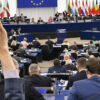Without being make or break for the European Union, the first six months of 2016 could be make and break for current major European policies. Overall, the main challenge is to maintain political coherence. This should be a priority for the Dutch Presidency. The rift between the north and south of the Union can be seen by all. It has been honed by the eurozone’s governance rules, confirmed by the results of the recent national elections in the south and highlighted by the ongoing spat between the Italian government and the Commission. A rift between the west and the east has now also become palpable. It has been spurred by the immigration crisis but is driven too by a growing disparity in economic structures and different approaches to political methods. These have hitherto been masked by the perceived need to counter Russian “expansionism”. Meanwhile, the possibility of a major EU player leaving the Union is further compounding uncertainties. By putting a priority on promoting political cohesion, starting with immigration, the Dutch presidency could help to lay the basis for an effective consolidation of EU decision making. At present, institutionally, it is probably in the best position to do so.
Written Statements









Post a comment